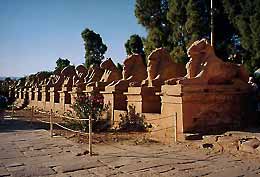TO LUXOR©
TO LUXOR©
Luxor is 400 miles south of Cairo. A thousand years before the Greeks built the Parthanon this place was called Thebes and was Egypt's religious capital for many centuries. We flew here at mid day on Egyptair. From the plane we looked down on a green Nile valley hemmed in on both sides by an extremely rugged desert with huge sand dunes and mountainous areas. For the entire one-hour flight, we flew over this landscape that seemed part Martian, part lush Oasis.
Lynne and I used Egyptair for a total of three flights. It was the most "on time" airline and had better food than KLM or NW. The staff was very nice. It was also the most international airline with people wearing clothes, speaking languages, and having skin colors that gave me no idea where they were from. Many of the men also seemed to be traveling with several wives.
We landed at the small Luxor International Airport. No lines, no tension,
nothing like the airport in Cairo. Driving to the Emilio Luxor Hotel was
nothing like driving in Cairo either. Luxor has a small town feel to it
and is prosperous only to the extent that people visit the nearby ancient
temples and the Valley of the Kings across the Nile.
It is tourist centered. Our hotel was old and small with a 1960's renovation
that was showing it's age but the location was in the center of town.
I would definitely stay there again.
 Our guide Sayed was waiting for us. We left with him to visit the temples.
What we saw took our breath away.
Our guide Sayed was waiting for us. We left with him to visit the temples.
What we saw took our breath away.
The Karnak temple area looked like Moses could have come out and greeted us. It is 200 yards wide and 4-500 yards deep and is surrounded by thick walls and filled with tall columns made of large blocks of yellow-red sandstone. These surfaces are covered with hieroglyphic inscriptions and relief sculptures of kings and gods. Many show their original paint and new repairs. Karnak was the first time we saw big crowds of tourists. A busload or two arrived every fifteen minutes. They moved through the temple in a rush, and then moved on. I am glad we didn't see Egypt on that kind of a tour.
We slowly wandered down a long central corridor to a small room where the Holy of Holies was kept. Sayed told us that the ancient religion claimed that God had inseminated the Mother of the King. Ancient Egyptians also believed strongly in life after death, not just for kings but also for commoners if they were good. These concepts appear in many current religions. Sayed said that Karnak had been devastated over the last 1500 years. The columns were pulled down, the statues defaced or buried. The place ended up being used as the town dump and toilet. It seems that the Christians and then the Moslems were offended by what they saw. Do these columns look offensive to you?
Lynne, Sayed and I left the inner sanctum by another route, seeing fortress like walls turning red courtesy of another blazing sunset. We walked past a row of magnificient guardian sculpture. These were a few of the hundred that lined the entire two miles between the Karnak Temple and the Luxor Temple. It was a warm 85 degrees with a slightly cooler breeze blowing. We were slogging through sand; I felt light-headed from the last hour of experience and general tiredness. Lynne and Sayed were getting too far ahead of me. That's when an Egyptian vendor around ten years old tried an old trick on me-a gift. He pressed into my hand a palm size rock carved into a green scarab. It felt and looked good. He wasn't taking it back. I bargained him down from 30 to 20 Egyptian pounds ($7) for what is a great paperweight. I bought it. Then the next boy wanted to sell me 2 of them for 5 pounds. Sayed said that it was really just plaster from a mold the boys make and paint and that I had given him a lot of money. Well, at least the kid was happy and I have a paperweight from Egypt I see everyday. Sayed seemed disappointed in me. He said that tomorrow he would take us to a place where real rocks were carved by men. Tonight, we still had the Luxor Temple to see.
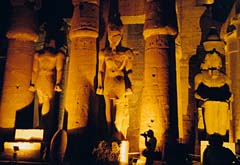 I
was more impressed by the beauty and proportions of Luxor temple than
any other architectural structure I have ever seen in my entire life.
We were exhausted. After only an hour there went back to hotel for the first
disappointing meal of the trip and bed.
I
was more impressed by the beauty and proportions of Luxor temple than
any other architectural structure I have ever seen in my entire life.
We were exhausted. After only an hour there went back to hotel for the first
disappointing meal of the trip and bed.
The next morning we crossed the Nile by bridge and drove to the Valley
of the Kings. The hundreds of royal tombs around the pyramids had already
been looted by 1200 BC. This valley was selected as the royal cemetery
because they thought its remote location would prevent looting. There
was also a natural rock formation in the shape of a pyramid towering above
the valley.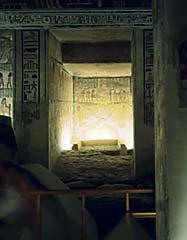 The tombs of the Egyptian kings here are man-made corridors and rooms.
They were cut out of solid rock and are in an excellent state of preservation,
covered with beautiful paintings and hieroglyphs. We were surrounded by
a rugged, mountainous, desert. It was less than 80 degrees in the tombs
and over 100 outdoors. Our hottest day. We spent a couple hours in the
tombs.
The tombs of the Egyptian kings here are man-made corridors and rooms.
They were cut out of solid rock and are in an excellent state of preservation,
covered with beautiful paintings and hieroglyphs. We were surrounded by
a rugged, mountainous, desert. It was less than 80 degrees in the tombs
and over 100 outdoors. Our hottest day. We spent a couple hours in the
tombs.
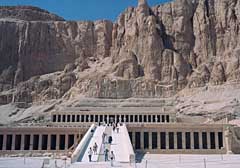
Sayed did take us to an "alabaster factory" and wholesale store. Men were sitting outside in the shade carving alabaster stones into jars. The owner came out and explained the ancient technique to us. Inside were jars and beautifully carved statues of Egyptian Gods and Goddesses, more scarabs, even stone lamps. I knew that shop owners and guides could work together. If we wanted a few high quality, small treasures to give to our kids and friends we were on our own here.
Prices were not marked here. The owner, Mohammed, who looked like a young Victor Mature, encouraged us to pick first and haggle later. We did both. We picked eight small figures and he wanted a couple of hundred dollars for them. I offered one-sixth and he reduced his price by ten percent. I put some back on shelves; he put them back on the table and cut his price again. This went on for awhile and I enjoyed it for the first few minutes. These were six-inch high hand-carved stone artworks. They took someone hours to make. Each one had hieroglyphs cut around the base. Mohammed brought out Turkish coffee. I forgot the "I am leaving now without buying anything" technique. He employed the "if I see in your eyes that you are weakening the dealing is over" technique. We paid about one-third the asking price.
In the late afternoon, back at the hotel, I went swimming on the roof
and watched the Nile flow by. I also sat on our fourth floor balcony for
an hour and watched the street below like it was theater. This scene included
a variety of mechanized and animal powered vehicles, Egyptian students
and workers, and tourists from around the world. A Tanker truck came by
and sprayed water on the dusty street. Luxor mini-buses just slowed down
and the passengers jumped on and off.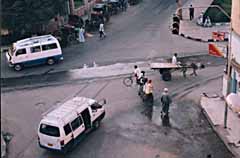 The traffic light seen in this picture didn't work. It was too high up
for drivers to see anyway.
The traffic light seen in this picture didn't work. It was too high up
for drivers to see anyway.
It was warm and breezy and the beautiful sunset was starting again. Workers in the cafes, carriages, and shops were preparing for the evening's business. One man methodically washed the sidewalk and street in front of his coffeehouse. As you read this now he will be doing it again tonight but for us this was very exotic.
At nightfall we were driven to the Luxor Museum and saw a magnificent display of a couple dozen, life size sculptures carved from granite and other hard stone. They were of humans and gods and all recently excavated from nearby temples and tombs. Some were extremely life-like and sympathetic. Others were surreal. All of them were of the highest quality, like Michaelangelo's David, only ancient Egyptian, and thousands of years old.
At about 7 PM Lynne and I went to the Luxor train station to begin our return journey-to a half day in Cairo, then a flight to Athens, then an early morning flight to Amsterdam, and finally Philadelphia. We were now on the way home.
The overnight train was right on time. Ahmed got us reservations for a private compartment in a sleeper car. It was just like in the movies. We were served dinner in our compartment. We had drinks in the club car. We watched rural Egypt go by our window. Every small town train station had a cafe where Egyptian men sat around, drank Turkish coffee, smoked the houka, and watched the trains go by. We only stopped twice. The moonlit landscape included farms, railroad crossings, and small factories. The bridge over the Nile was an old steel structure of the "Trenton Makes, the World Takes" variety, only much longer.
Before I fell asleep to the train's clickety-clack and slow rocking motion I was reflecting on our journey and how it turned out to be an adventure. I was thinking that it was almost as good an adventure as my two months of hitchhiking around Europe when I was 21. But the trip wasn't over. I thought the end of the trip was beginning tonight but our last day in Cairo added a different dimension to the story.
